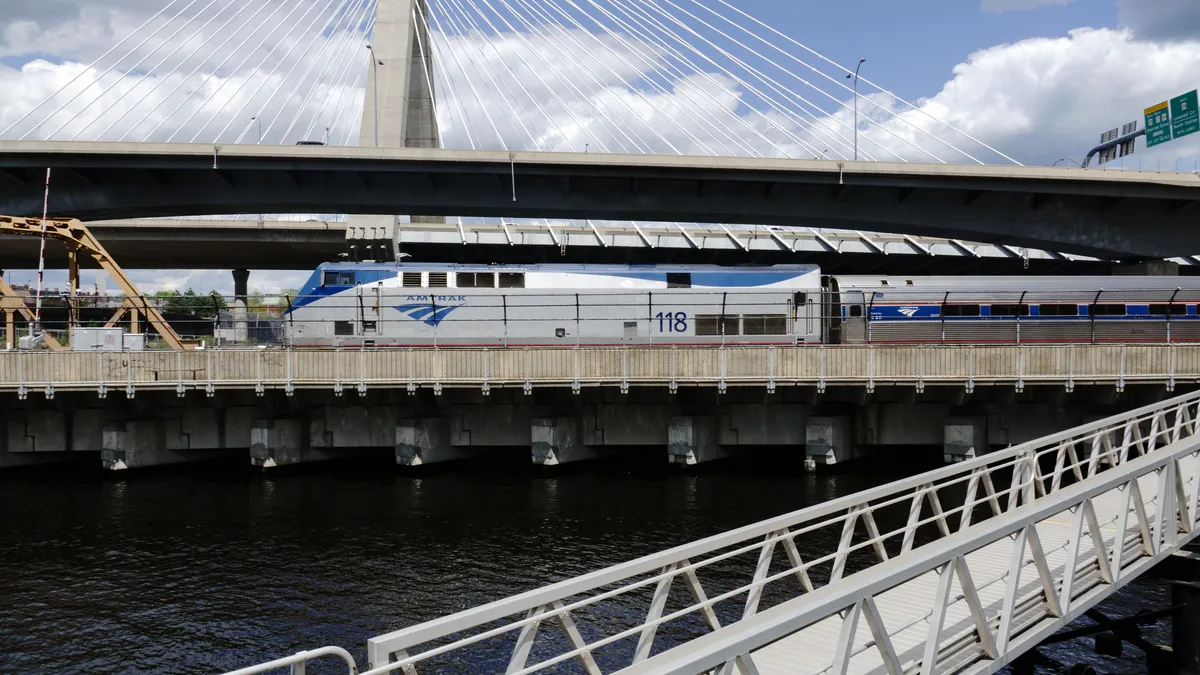Massachusetts Gov. Maura Healey wants to establish new intercity rail passenger service along an existing rail line from Boston to Worcester, Springfield and Pittsfield, Massachusetts, but Rep. Seth Moulton, who represents the Northeastern part of the state, has another idea: Build a new high-speed rail line from the ground up.
Amtrak currently runs one train a day in each direction along the Boston-Pittsfield line, a long-distance train with sleeper cars that terminates in Chicago. A 2021 study the Massachusetts Department of Transportation conducted states that “fast and frequent passenger rail service” along this corridor could enhance mobility and connectivity for communities along the line and spur economic development. But Moulton said in an interview that the state “wants to build a 19th-century railway.”
The road distance from Boston to Springfield is roughly 90 miles, which can be driven in as little as 90 minutes on an interstate highway. Amtrak’s train takes about three and a half hours with three intermediate stops. Regarding the proposed new service along the same line, Moulton said, “People aren't going to ride it unless it's faster than driving.”
On the state’s proposed route west of Worcester, the tracks to Pittsfield are owned by CSX, one of the nation’s largest freight railroads. According to the MassDOT study, significant stretches of the line are a single track, and train speeds west of Springfield are restricted to less than 60 mph. The report warns that passenger service along this line “would require careful coordination of services and clear operational criteria, as well as an agreement with CSX,” to operate passenger trains along their right-of-way.
Jim Mathews, president and CEO of the nonprofit Rail Passengers Association, said he agrees with Moulton, and the association supports the construction of high-speed rail for this route. Connecting major population centers along a short corridor is “the ideal use case” for high-speed rail, Mathews said, adding it “may be the best way to advance high-speed rail in the United States.”
The East-West Rail, as the project is known, isn’t the only major rail project advocates would like to move forward in Massachusetts.
Boston has two passenger rail terminals, North Station and South Station, that are one-and-a-half miles apart. Plans to connect them go back more than 100 years, but they have never come to fruition. Amtrak passengers from Maine arriving at North Station need to take a taxi or subway ride to South Station to continue their journey if traveling beyond Boston. Commuter rail lines terminate at each station, preventing riders from easily crossing Boston to reach destinations on the opposite side of the city.
A connection between the two stations, called the North-South Rail Link, is not going to happen anytime soon. “There's no step right now to be shovel-ready at any point,” said Joseph Aiello, national field coordinator for RPA. A draft environmental impact report and investment study from 2003 needs to be restarted and completed, Aiello said.
There’s little agreement on what a North-South Rail Link would cost. A 2019 MassDOT feasibility study put the figure at between $12.3 billion and $21.5 billion. A 2017 estimate by Harvard Kennedy School researchers put it between $3.8 billion and $5.9 billion in 2025 dollars.
Advocates, led by former Massachusetts Gov. Michael Dukakis and former state Rep. John Businger, are trying to revive interest in the project, Aiello said. It also has the support of the Massachusetts chapter of the Sierra Club. “We're trying to prod the new Healey administration to get off the dime on that issue,” said John Kyper, co-chair of the chapter’s transportation committee.
Moulton weighed in on this project as well. “Boston has known for so long that we need to build this rail link, and we just can't wait any longer. We need to start,” he said.












